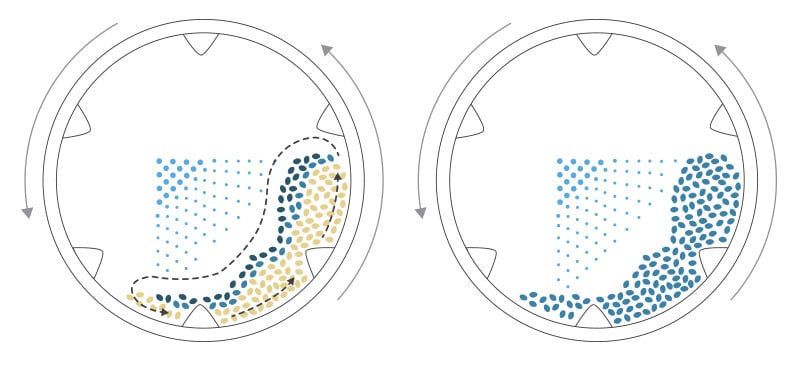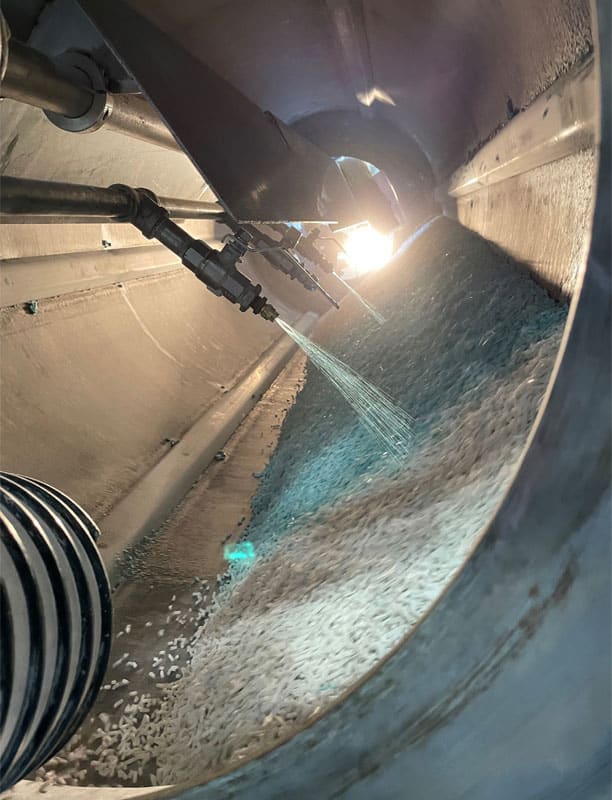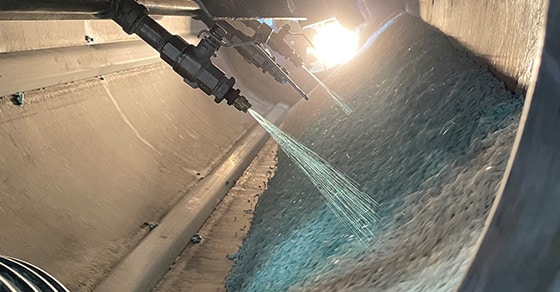Rotary drums have long been a cornerstone in catalyst manufacturing, particularly for incipient wetness impregnation—a critical step in catalyst preparation. FEECO International, a leader in custom rotary drum design and manufacturing, has extensive experience in engineering equipment that delivers precision, efficiency, and customization. Combined with the advanced testing capabilities found in the FEECO Innovation Center, we provide catalyst producers with a trusted partner in scaling up impregnation processes for commercial production.
In this article, we’ll explore why rotary drums are the preferred choice for impregnation and how the FEECO Innovation Center supports the development and optimization of these systems for catalyst manufacturers.
About Incipient Wetness Impregnation
Most heterogeneous catalysts are produced via impregnation, in which the active catalytic component is overlaid onto an already-formed solid support material, making the process one of the most critical steps in catalyst preparation.
Also known as pore volume or dry impregnation, incipient wetness refers to the specific technique of spraying a solvent containing the active catalytic component onto a solid support material, the solvent containing just enough of the active component to fill up the pore volume and achieve the desired loading.[1] Support porosity and solution concentration are key factors in determining how much activated component is adsorbed by the support.[2]
The pre-formed support, which may be produced through various process techniques, can be produced in a myriad of shapes. Spherical granules produced via pelletizing can offer a particular advantage to the incipient wetness impregnation technique, promoting a more uniform distribution of the catalytic component over the solid support.
Impregnation is followed by drying to remove any remaining solvent and calcination to chemically bond the catalyst to the support.

3D Rendering of a FEECO Impregnator
Why Rotary Drums for Impregnation?
Typically referred to as “impregnators” in this setting, rotary drums can provide the optimal conditions for incipient wetness impregnation, thanks to two key features:
Bed Turnover
Effective impregnation relies on the uniform distribution of the solvent onto the support material; spraying only the top-most surface of a stationary pile would be ineffective and inefficient. As such, motion is needed to disperse the solvent and achieve uniform distribution, and this is where the tumbling action imparted by rotary drums provides a clear advantage.
The tumbling action of the rotating drum creates bed turnover, often with the help of tumbling flights. These, as shown in the illustration below, help to ensure that the bed is adequately turned, as opposed to simply sliding along the drum’s interior. Rotational speed of the drum also has an influence on bed turning.
Combined with a strategic spray system design, this tumbling action evenly distributes the solution throughout the material bed for a uniform result, as shown in the illustration below.

In this way, impregnation in a rotary drum is very similar to coating, during which the rotation of the drum helps to evenly distribute the liquid coating throughout the material bed via granule-to-granule contact. In fact, the only difference between what one might consider an “impregnator” and a “coating drum” is the end goal; coating drums are intended to apply a coating to the surface of a material, while impregnators are intended to cause the support material to absorb the component into its pore spaces.
Opportunity for Customization
In addition to bed turnover, the other major benefit these impregnators offer is their significant potential for customization, which is often key to achieving product goals in catalyst preparation.
While the concept of impregnation may seem simple enough, achieving the desired result is often another matter. The ability to reach the desired characteristics in the final product is highly specific to each production line, with innumerable factors playing into success, so much so that catalyst manufacturing is often considered an art.
Producers take great care in tailoring their systems to their specific needs, incorporating product quality goals, raw material requirements, and process objectives. Their needs simply cannot fit within the confines of inflexible equipment, and this is where rotary drums provide a much-needed option.
Several aspects of the impregnation drum, as well as associated process parameters, can be manipulated to meet product quality and operational goals. This includes:
- Drum diameter and length
- Solid feed rate
- Spray rate
- Spray concentration
- Number and location(s) of sprays
- Nozzle type
- Spray temperature
- Drum rotational speed
- Drum slope
- Retention time
- Internals for optimizing material bed action
- Bed depth (percent fill)
Combined with the complex nature of catalyst manufacturing, this opportunity for customization gives catalyst producers the flexibility they need to tailor the system according to their unique feedstock and product requirements.
At the same time, this high level of flexibility can also make identifying the right combination of factors a challenge for catalyst producers, especially when considering that each material responds differently to the process. This is where testing facilities like the FEECO Innovation Center bring immeasurable value.
Testing Incipient Wetness Impregnation
Thorough testing and process development work is critical to achieving desired loading via impregnation.
Further, producers must not only be able to develop a process that will consistently produce the desired results, but then must also scale up that process to continuous production.
The FEECO Innovation Center offers a unique testing environment where catalyst producers can experiment with various aspects of impregnation through the use of a pilot-scale coating drum.
One of the major advantages to the Innovation Center is that the facility is also equipped to test catalyst support formation via pelletizing, as well as both drying and calcination.

Impregnation testing in the FEECO Innovation Center
Scaling Up Impregnation
In addition to developing new or improved products, the Innovation Center can assist producers in transitioning their existing batch operations to continuous scale, a growing trend in the industry.
Testing in this aspect provides the data necessary for designing commercial-scale equipment, significantly reducing the risk in transitioning from a batch to continuous operation.
Conclusion
Rotary drums offer significant advantages in performing incipient wetness impregnation, providing catalyst producers with the precision and flexibility necessary to meet the intricate demands of catalyst preparation.
Through testing and process development in the FEECO Innovation Center, catalyst manufacturers can fine-tune their operations and confidently scale up to continuous production, ensuring a smooth transition while minimizing risk.
FEECO is a leader in engineering and manufacturing custom rotary drums for a range of processes, including impregnation, drying, and calcination. Backed by testing in our Innovation Center and an expert parts and service team, catalyst producers can be confident in their FEECO rotary drums. For more information, contact us today!
SOURCES:
- Averill, B. A., & Santen, R. A. van et al/ E. (1999). Catalysis: An integrated approach. Elsevier.
- Twigg, M. V. (1996). Catalyst Handbook (2nd ed.). CRC Press.



